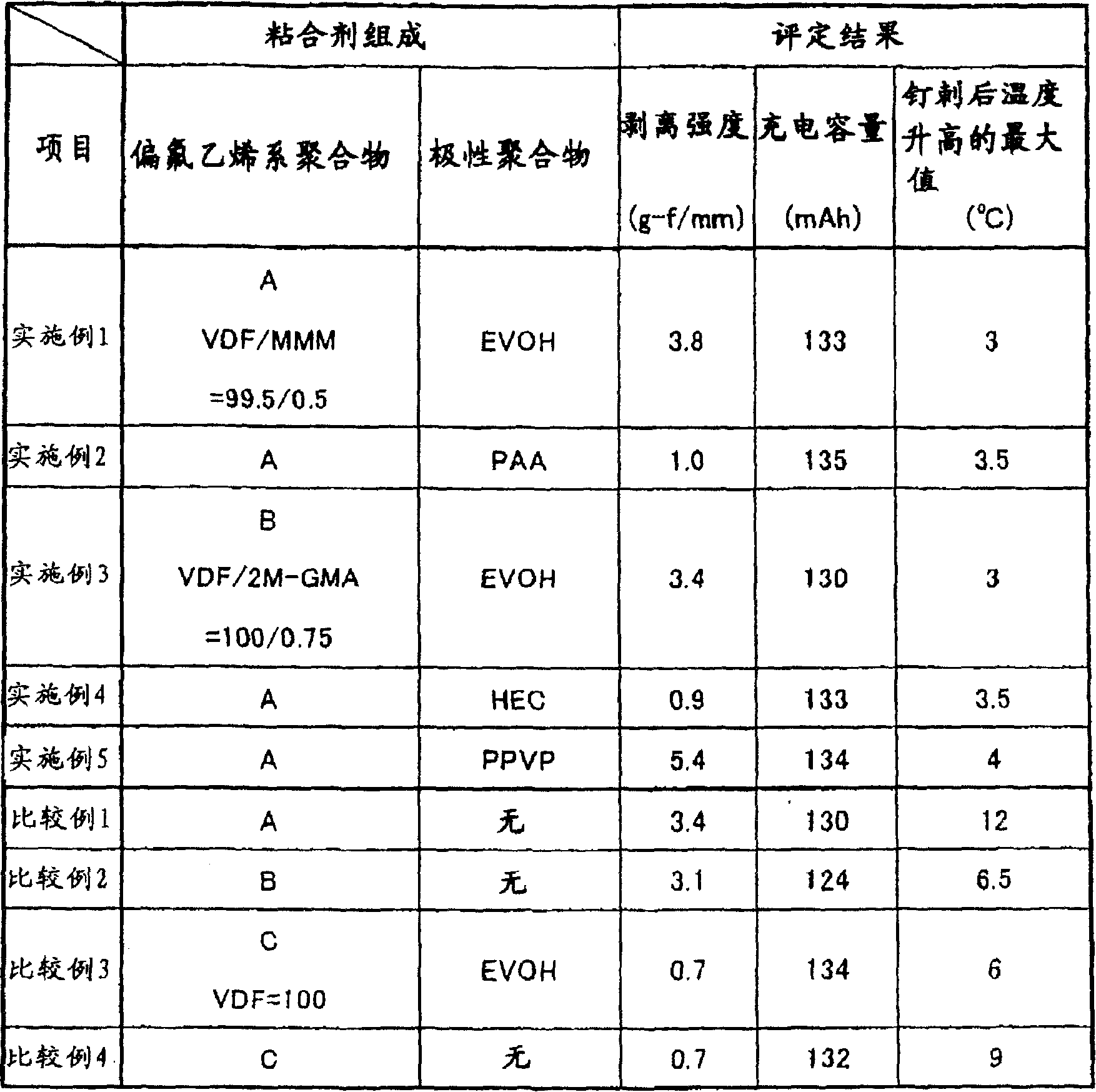Binder composition for electrode of nonaqueous electrolyte battery, and electrode mixture, electrode and battery using same
A non-aqueous electrolyte and battery electrode technology, applied in non-aqueous electrolyte battery electrodes, non-aqueous electrolyte batteries, battery electrodes, etc., can solve problems such as smoke, insufficient adhesion, and increased risk
- Summary
- Abstract
- Description
- Claims
- Application Information
AI Technical Summary
Problems solved by technology
Method used
Image
Examples
Embodiment 1
[0035] (preparation of positive electrode)
[0036] Add N-methyl-2-pyrrolidone (NMP) to 94 parts by weight of lithium cobaltate ("Cellshid C-5", manufactured by Nippon Chemical Industry Co., Ltd.), 3 parts by weight of vinylidene fluoride polymer C, and 3 parts by weight of carbon black. 43 parts by weight, mixed to prepare a mixture for the positive electrode. The obtained mixture is evenly coated on an aluminum foil with a thickness of 10 μm, so that the thickness of the coating film after drying is 100 μm, and dried at 130° C. for 25 minutes to obtain a positive plate structure (active material amount: 291 g / m 2 ).
[0037] (preparation of negative electrode)
[0038] For 11 parts by weight of vinylidene fluoride polymer A containing functional groups, 1 part by weight of ethylene-vinyl alcohol copolymer (manufactured by EVOH, クレハ company, "Eval EP-G156B", the molar content of ethylene is 47%), add Composition A of the negative electrode mixture of the present invention ...
Embodiment 2
[0051] When preparing the negative electrode, polyacrylic acid (PAA) ("AQUPEC HV-501", manufactured by Sumitomo Seika Chemical Co., Ltd.) was used instead of EVOH. In addition, the same operation as Example 1 was carried out to obtain negative electrode structure B, namely battery B .
[0052] The peel strength of the negative electrode structure B was 1.0 gf / mm, the charging capacity of the battery B was 135 mAh, and the maximum temperature increase in the nail penetration test was 3.5°C.
Embodiment 3
[0054] When preparing the negative electrode, the vinylidene fluoride polymer B containing the functional group is used instead of the vinylidene fluoride polymer A containing the functional group. In addition, the same operation as in Example 1 is carried out to obtain the negative electrode structure C, that is, the battery c.
[0055] The peel strength of the negative electrode structure C was 4.3 gf / mm, the charging capacity of the battery C was 130 mAh, and the maximum temperature increase in the nail penetration test was 3°C.
PUM
| Property | Measurement | Unit |
|---|---|---|
| peel strength | aaaaa | aaaaa |
| peel strength | aaaaa | aaaaa |
| peel strength | aaaaa | aaaaa |
Abstract
Description
Claims
Application Information
 Login to View More
Login to View More - R&D
- Intellectual Property
- Life Sciences
- Materials
- Tech Scout
- Unparalleled Data Quality
- Higher Quality Content
- 60% Fewer Hallucinations
Browse by: Latest US Patents, China's latest patents, Technical Efficacy Thesaurus, Application Domain, Technology Topic, Popular Technical Reports.
© 2025 PatSnap. All rights reserved.Legal|Privacy policy|Modern Slavery Act Transparency Statement|Sitemap|About US| Contact US: help@patsnap.com

